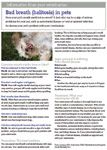Use bad breath as an intro to discuss oral care
Stinky pet breath. Your clients might find it off-putting, but they probably don't know halitosis can be a sign of serious medical problems, such as periodontal disease or oral or systemic infection.
Stinky pet breath. Your clients might find it off-putting, but they probably don't know halitosis can be a sign of serious medical problems, such as periodontal disease or oral or systemic infection.

"A lot of people feel pets are supposed to have bad breath and they live with it," says Dr. Scott Linick, a fellow of the Academy of Veterinary Dentistry and owner of Plainfield Animal Hospital in South Plainfield, N.J. "But most of the time it's due to dental disease." Educating clients about the importance of odor issues can be a delicate process, but your goal is to get the pet into an exam room so you can identify the source of the problem.

Educate early and often
First step: Get clients on board when a pet's young. That's the theory behind most puppy and kitten kits, and it works. When else are your clients more enthusiastic learners than when they first bring home their sweet little bundles of joy? A halitosis handout is a good reminder for clients that their pet's bad breath is not normal—and it prepares them to offer the important oral care their pets need for a healthy lifestyle. Dr. Linick pairs this handout with a worksheet on brushing a pet's teeth. And be sure to remind clients that, even with the best home care, their pets will need dental cleanings periodically to keep their mouths healthy.
Getting to yes
You may feel reluctant to propose a dental cleaning because you're afraid of rejection or you think clients can't afford it. Put those worries aside for now, says Dr. Linick, and focus on what the pet needs. You might be surprised by how often the answer is yes.
To encourage positive answers—and make sure clients follow up with a scheduled appointment—Dr. Linick makes a note of his recommendation on his practice's travel sheet. If the client doesn't schedule the appointment right away, this triggers receptionists to call back in two weeks. This is what they say: "Dr. Linick saw your pet two weeks ago, and he noted your pet has this dental disease. Your pet really needs a cleaning—would Tuesday be good for you?"
Why clients resist
When clients say no, Dr. Linick says it's usually about more than money. Objections are often motivated by concerns about the pet's health. "They're worried about anesthesia," he says. "So to make the procedure as safe as possible, we do preanesthetic tests so we can minimize complications and client fears."
Dr. Linick uses blood tests and electrocardiograms to determine whether pets are candidates for general anesthesia. With these results, he can confidently recommend a dental procedure. And, he says, he always reminds clients that the best oral care starts with good home care to prevent dental disease and odor.
The bottom line: "I try to stress that prevention is key," Dr. Linick says. "We need to be aggressive about getting clients to offer regular dental care before pets suffer from disease."